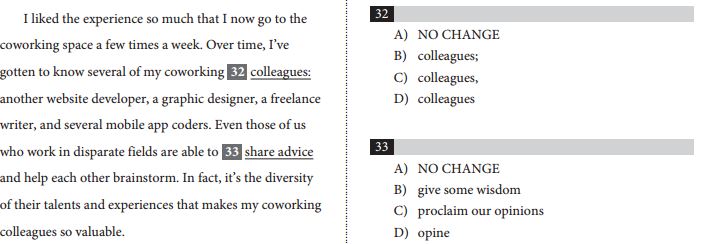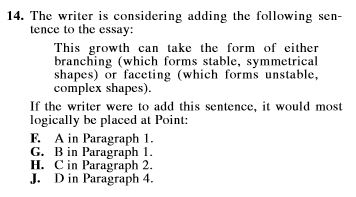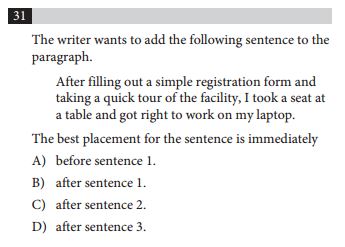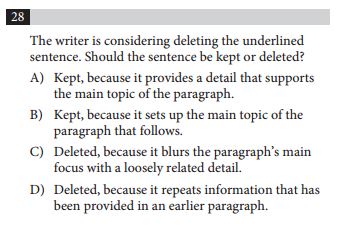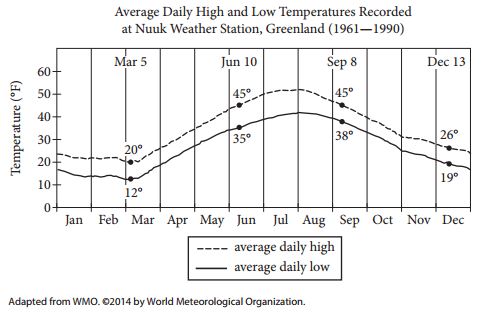ACT Reading Blog Post
Should I Skim the Questions Before I Read the Passage?
 I get the “should I start with the questions?” question a lot. It’s a popular approach taught by many test prep helpers. The approach sounded like it had merit, so…
I get the “should I start with the questions?” question a lot. It’s a popular approach taught by many test prep helpers. The approach sounded like it had merit, so…
I sat down this week to do something I can’t remember ever trying before–skimming the questions before reading the passage and answering the questions on an ACT Reading test.
I thought skimming the questions would help me with the questions that were detail specific. I already knew there would be “big picture” questions dealing with theme and the purpose of paragraphs (because there are on every ACT Reading passage).
All items shown below are from the 2016-2017 Preparing-for-the-ACT Guide. They are the property of ACT Inc., not 36 University.
Here are the 10 questions I skimmed. I have highlighted the portions I initially underlined so you can see my thought processes and to help you read more quickly.










Here’s what happened:
- My initial skim seemed helpful. I knew I had to focus on photos by Bombay’s great photographers (Q1), several sets of lines (Q3, Q6, Q7, Q9), and how the narrator viewed his parents’ work (Q8), among others.
- But I had a hard time remembering the questions while trying to absorb the passage, and I knew absorbing the passage was essential because big picture items (Q1, Q7, Q8) were coming.
- I still had to reread the questions anyway. The questions were detailed enough so that I had to reread them to make sure there weren’t any nuances I missed in my initial skim.
- I ran out of time!!! It took me about 50 seconds to skim the questions. On average, you get 8 minutes and 45 seconds per passage. I went over that mark by about 15 seconds. That may not seem like much, but if I missed the pace by that much on all four passages, I’m a minute over the allowed time.
My Recommendation
I suggest reading the passage first. Keep a pace that allows you to remember key details while still soaking in the subtleties of the passage. Use the questions to guide you to parts of the passage that you may need to reexamine. They often specify paragraph or line placement to make your job even easier.
If you still think skimming the questions first is for you, I suggest you develop a quick notation system that helps you remember the questions and work through them more quickly when you get back to them. Practice enough so that you know which types of questions you want to try to keep in mind as you read the passage. Ultimately, check your approach (using a practice test) versus the more traditional passage-then-questions approach to see which one gives you the best score.
Dr. Kendal Shipley, 36U President
5/25/2017
Side-by-Side Comparison of the Updated ACT and the New SAT

Wow! The SAT has changed. Instead of 10 smaller sections, now there are 4 bigger tests, just like the ACT. The SAT no longer penalizes for guessing. And the essay is now optional. It has even begun incorporating science items in the English and reading tests. To top it off, question formatting is very similar, too. Let’s get right to it…
(This post contains screenshots of items released by ACT Inc. and the CollegeBoard (makers of the SAT). The items are not the property of 36 University.)
Test Order and Structure: ACT vs SAT
Both tests have 4 main tests and an optional essay.
|
ACT |
SAT |
| Section 1 |
English (75 questions in 45 min) |
Reading (52 questions in 65 min) |
| Section 2 |
Math (60 questions in 60 min) |
Writing/Language (44 questions in 35 min) |
| Section 3 |
Reading (40 questions in 35 min) |
Math (20 questions in 25 min). Last 5 are grid-in. |
| Section 4 |
Science (40 questions in 35 min) |
Math (38 questions in 55 min). Last 8 are grid-in. |
| Section 5 (Optional) |
Writing (Optional Essay in 40 min) |
Essay (Optional in 50 minutes) |
| Total Time |
2 hrs 55 min or 3 hrs 35 min w/ Essay |
3 hrs or 3 hrs 50 min w/ Essay |
Scoring
|
ACT |
SAT |
| Max Score |
36 |
1600 |
| Details |
Each test has max score of 36.
Composite is average of four scores. |
SAT Reading max score: 800
SAT Reading derived from Reading & Writing/Language.
SAT Math max score: 800
SAT Math score derived from 2 math sections.
Composite is sum of Reading and Math scores. |
There is no penalty for wrong answers on either test.
Writing scores are kept separate from the other scores on both tests.
Subject Comparisons
ACT English vs SAT Writing/Language
The English tests on both the ACT and SAT have a very similar structure. The SAT English incorporates science graphs occasionally and seems to require a slightly more extensive vocabulary.
ACT Math vs SAT Math
|
ACT |
SAT |
| Setup |
60 questions in 60 minutes |
Part 1 (no calculator): 20 questions in 20 minutes (15 MC, 15 Free Response)
Part 2 (calculator): 38 questions in 55 minutes (30 MC, 8 Free Response) |
| Pace |
60 seconds per item |
Part 1: 60 seconds per item
Part 2: ~87 seconds per item |
| Question Format |
ACT Math has 5 answer choices. |
SAT Math has 4 answer choices on multiple choice questions.
SAT Math also has some Grid-In answer items. |
| Basic Items |
 |
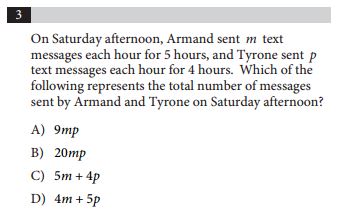 |
| Same Writers? |
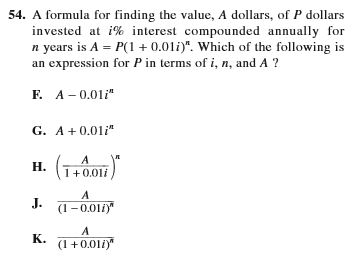 |
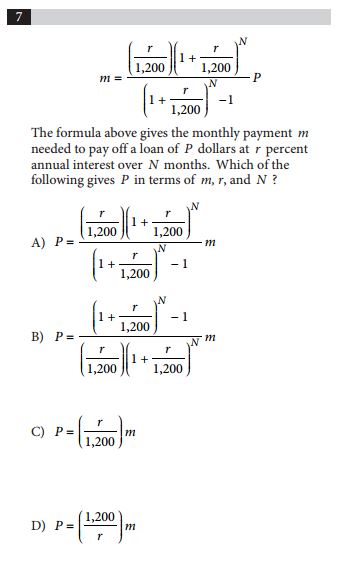 |
| Grid-Ins |
Not applicable. |

***Students grid-in answers on answer document. |
| Notes |
Calculator is allowed on all items. |
Calculator is allowed on Part 2, not Part 1. |
The math tests are not as similar as the English tests.
ACT Reading vs SAT Reading
|
ACT |
SAT |
| Setup |
40 questions divided over 4 passages
35 minutes |
52 questions divided over 5 passages
65 minutes |
| Pace |
52.5 seconds per item |
75 seconds per item |
| Passages |
4 passages:
Prose Fiction
Social Science
Humanities
Natural Science |
5 passages:
U.S. or World Lit
U.S. Constitution or Global Conversation
Social Science
2 Science passages |
| Comparison Items #1 |
 |
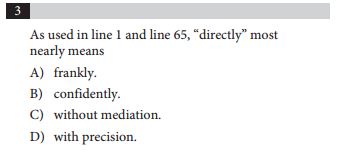 |
| Comparison Items #2 |
 |
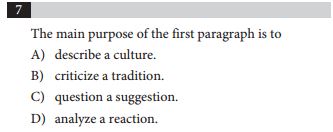 |
| Notes |
|
The SAT has begun adding items that require
students to locate justification in the text.

|
| Notes |
|
SAT Reading has science graphs included
in the 2 science passages.

|
As with the English tests, the Reading tests are very similar. On the SAT English tests, students will work with 2 science passages. On the ACT, the science is in a section on its own.
ACT Science in the SAT Writing and Reading
|
ACT |
SAT |
| Setup |
40 questions divided over 6 or 7 scenarios
35 minutes |
N/A |
| Pace |
52.5 seconds per item |
N/A |
| Question Format |
The ACT Science test requires students to interpret
information in tables and graphs.
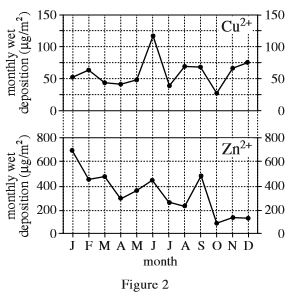
|
The tables and graphs are incorporated in the
SAT English and Reading tests.
|
| Basic Items |
Questions require students to evaluate
experiments and research.
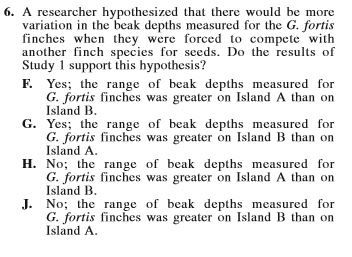
|
The tables and graphs are incorporated in the
SAT English and Reading tests. |
ACT Writing vs SAT Essay
|
ACT |
SAT |
| Setup |
1 essay in 40 minutes |
1 essay in 50 minutes |
| Format |
1 Central Question.
3 Perspectives Provided.
Students are asked to:
-state and develop their own position.
-analyze and evaluate the 3 perspectives
in light of their stated position. |
Students are given a relatively lengthy
passage to evaluate. Instead of stating
their own position, they are asked to dissect,
analyze, and evaluate the passage. |
| Examples |
You can find an example of an ACT Writing
test prompt provided by ACT Inc here:
Sample Prompt |
The Collegeboard has two sample prompts
available on its website:
Prompt 1
Prompt 2 |
Final Word
I don’t consider one test more difficult than the other, and the new SAT is new enough that I haven’t completed enough practice tests to make a complete assessment. At this point, maybe the most obvious difference between the tests is that 1/4 of the ACT score is derived from math items and 1/2 of an SAT score comes from math items.
Kendal Shipley, Ed.D.
6/3/2016
Recent and Related Posts
The Story of Lil Carl and the Arithmetic Series
Get a Copy of Your ACT and Fix the Mistakes
“Can you help me with test anxiety?” #30secondswiththeCEO
36U Blog List
36U ACT Tips
#30SecondswiththeCEO Videos List
36U ACT Prep Program
#1 Skill Needed to Score Well on the ACT May Be Reading Comprehension
Often, I hear from parents of students who have recently received ACT scores between 13 and 17. They are concerned that the low ACT score is going to limit their student’s college options and don’t know what skills to begin addressing.
Standardized tests don’t always accurately reflect what a student really knows or his capabilities, and sometimes students just have an off day on the day of the test.

However, more often than not, low ACT scores are symptomatic of one prevailing problem: poor reading comprehension. A student who has weak reasoning and math skills may score poorly on the math and science tests. A student who doesn’t understand the basics of grammar and punctuation will likely score poorly in English. But the student who doesn’t read well will be penalized on all four subject tests. As strange as it may sound, many times low ACT scores can be traced back to a student’s ability to read and comprehend.
(All of the released ACT items below are from 2015-2016 Preparing-for-the-ACT Guide and are the property of ACT Inc., not 36 University.)
The English Test and Reading Comprehension
Examine the two items below. By my count, they are representative of 24 of the 75 English items from the 2015-2016 Guide, and they require strong reading comprehension skills! As you can see, a struggling reader will struggle with the English test.
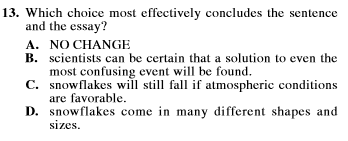
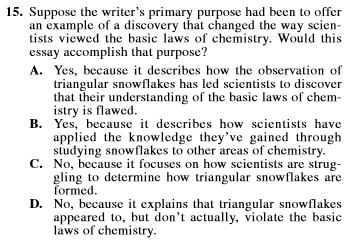
(If you missed our recent post The Juggling Act Required by the ACT, click here.)
The Math Test and Reading Comprehension
Maybe it’s not surprising that the English test requires strong reading skills, but the math test is text-heavy also. In fact, 39 of the 60 items from the 2015-2016 Preparing-for-the-ACT Guide required students to read at least 3 lines of text. Not all math items are like the three shown below, but many of them are.
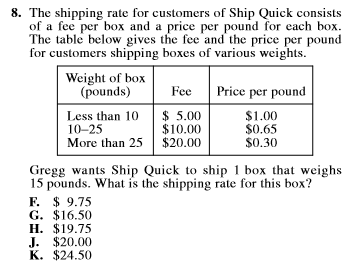
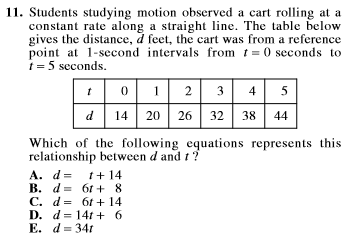
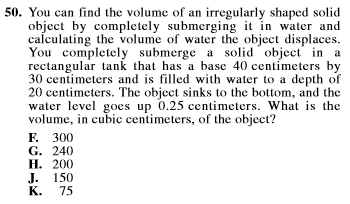
The Reading Test and Reading Comprehension
Of course, the reading test is all about reading comprehension, and it’s one-fourth of an ACT score! Sure, a fair number of the 40 items ask students to interpret meaning from what is explicitly stated in the text. However, a fair number also ask students to reason implicitly to determine inferences, main idea, compare and contrast, etc. It comes as no surprise that strong reading skills are required to score well on the reading test.
The Science Test and Reading Comprehension
To understand the importance of reading skills on the science test, you must first understand the test’s format. The science test consists of six or seven separate scenarios. One of those scenarios is comprised of only text, usually four or five paragraph’s worth. It is like a mini version of a reading scenario. All of the other scenarios require a significant amount of reading, too. In the 2015-2016 Preparing-for-the-ACT Guide, the other five passages accounted for another 19 paragraphs, almost 4 paragraphs per scenario.
To give you an idea of a typical ACT science passage, we have provided a sample passage from the same ACT publication we’ve used for this entire post:

Summary
As you can see, reading comprehension skills are needed on every section of the ACT. Scores in the 13 – 17 range are often a result of insufficient reading skills and not from a lack of content knowledge.
What Can I Do?
Be intentional! In your casual reading—through a news article, or your favorite blog, or that new novel—stop occasionally and ask yourself some very specific questions:
“What was the main idea of that paragraph?” (Try to summarize in 5 words or less.)
“Were the paragraph’s sentences presented in a logical sequence?”
“What was the main idea of the passage?”
“Were the paragraphs within the passage placed in a logical sequence?”
Intentionally evaluating and critiquing your reading material will make you a better reader and writer – and an improved ACT score will be a by-product of your new skills!
Recent and Related Posts
Get a Copy of Your ACT and Fix the Mistakes
The Juggling Act Required by the ACT English Test
3 Types of Probability Items to Expect on the ACT Math Test
36U Blog List
36U ACT Tips
36U ACT Prep Program
Your Week-Before-the-ACT Game Plan (Part 3 of 4: Reading)

This is the 3rd part in our 4-part series on finalizing your game plan the week before the ACT. It’s time to put a game plan in place for the Reading Test.
The Setup
There is no mystery here: you’ll have 35 minutes to answer 40 items. The 40 questions will be evenly divided over 4 passages. Each passage is fairly lengthy – almost 750 words (a little shorter than this blog post). Oh yeah, don’t forget that one of the passages will likely have two separate texts. That’s a relatively new twist. The first 6 or 7 items on the “double text” passage will ask you about the passages separately. The last few will ask you to evaluate relationships between the passages. If you want to give a double text passage a try, click here.
Start with the Questions or the Passage?
Some students insist on reading the questions before they head to the text. Some of these students even go so far as scavenging through the passage looking for answers rather than reading it. Students who use this approach often have difficulty perceiving big picture concepts like main idea or author’s purpose, and we know those questions will be asked. Students who have taken several ACT Reading tests should have a pretty good idea of the types of questions they ask already (more on this shortly). Other than knowing which details are targeted in the questions, there isn’t much to gain by reading the questions first. I suggest starting with the passage, reading slowly enough to remember details and at the same time looking to piece together the big picture.
Even students who read the passage often read it so hurriedly they miss key information. Either the average student reads almost twice as quickly as I do (in my experience, they usually get to the questions in about 2 minutes and it takes me about 4), or they aren’t reading carefully enough. Speeding through the passage in order to start the questions ends up costing students time because they find themselves having to reread a large portion of the passage to find answers. I find if I take my time reading the passage, making sure I understand the text, then I can run through the questions quickly enough to stay on pace.
The Passages Change; The Questions Stay the Same
As I mentioned earlier, we know what questions they are going to ask. Sounds rather bold, right? It’s not, really. Reading comprehension means essentially the same thing whether you’re reading an ACT passage or the sports page or Moby Dick. Skilled readers are able to visualize and remember details while staying sensitive to a passage’s purpose and tone. The ACT’s questions are going to test how well you remember those details and how well you comprehend purpose and tone, too.
So, here’s what you can expect from each set of 10 items. There will be several questions based on what is explicitly stated in the text. Usually these answers can be found in a particular sentence or two within the passage. We call these Level 1 items. Level 2 items will ask you to read between the lines to figure out what the author meant. These answers will usually be found in a specific area of the text. You may have to reread a few sentences. And the most difficult items will test your understanding of the passage on a larger scale: Why is the purpose of the 3rd paragraph? What is the main idea of the passage? We call these Level 3 items. These are precisely the types of questions that may give you trouble if you choose the scavenger hunt approach.
A Game Plan
My game plan for attacking the ACT Reading is something like this:
Though the passages seem lengthy, this is one of the ACT’s shorter sections. There are only 40 items, and it will be over in 35 minutes. That’s good, because it won’t leave me mentally drained. Stay calm and confident. Keep a steady, moderate pace. Read the passages carefully, underlining details that seem important. Details will help me answer Level 1 and Level 2 questions. At the same time, prepare for Level 3 items by observing the structure of the passage and noting the writer’s perspective and purpose. On average, I have a little less than 9 minutes per section. From previous practice, I know I can comfortably read through most passages in about 4 minutes, leaving me about 5 minutes for the questions.
If your approach is radically different than mine, now is probably not the time to change it up. Write out your own game plan, one that matches what you have already practiced. At the end of the day, you want to be confident your approach gives you the best opportunity to make your best score.
Recent Posts:
Your Week-Before-the-ACT Game Plan (Part 2 of 4: Math)
Your Week-Before-the-ACT Game Plan (Part 1 of 4: English)
 I get the “should I start with the questions?” question a lot. It’s a popular approach taught by many test prep helpers. The approach sounded like it had merit, so…
I get the “should I start with the questions?” question a lot. It’s a popular approach taught by many test prep helpers. The approach sounded like it had merit, so…![]()
![]()


